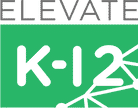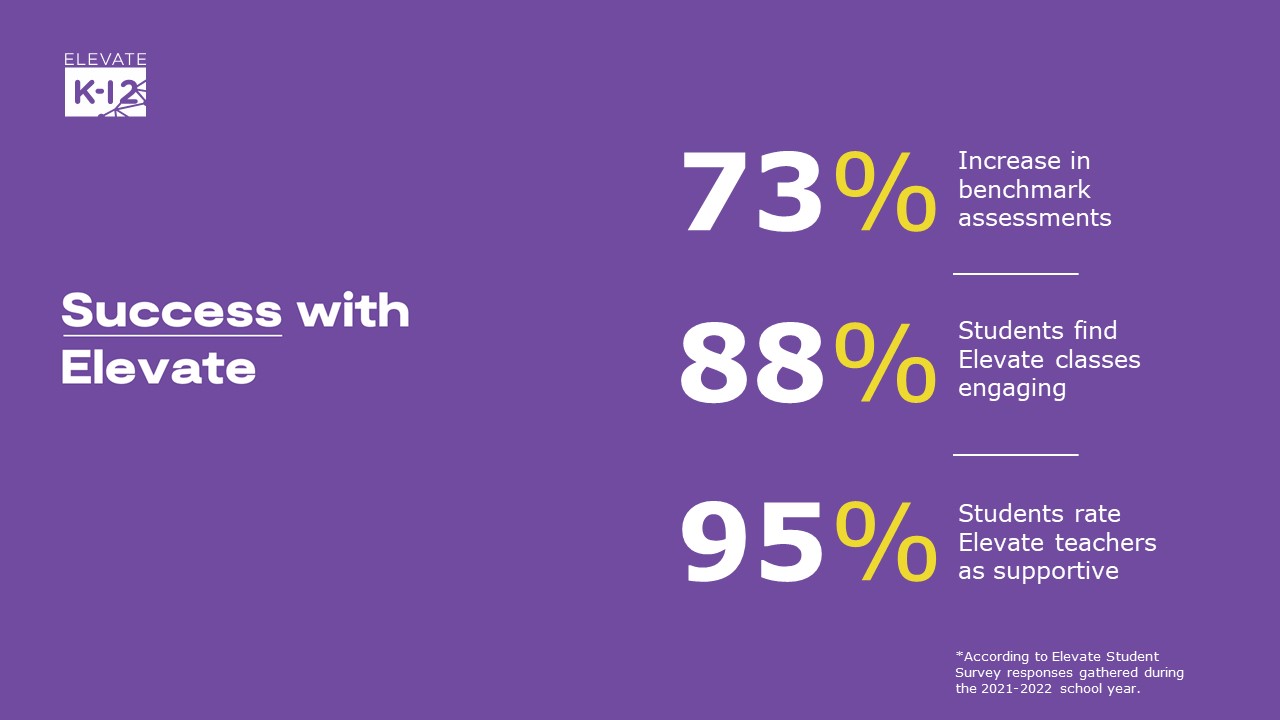Are you facing the daunting challenge of addressing compliance in special education classrooms while grappling with teacher shortages? Elevate K-12 has the perfect solution for you! Our recent webinar, “Meeting Special Education Needs with Limited Resources,” showcased the game-changing LIVE Teaching Special Education Resource Room, designed to revolutionize how you support students with IEPs.
Introduction
Steven 00:02
Hello, everyone, and welcome to our district administration Ed talk here today, which is entitled, “Meeting Special Education Needs with Limited Resources.” And all of this is brought to you by the generous support of our sponsor that we have with us, Elevate K-12. Since our Ed talks are brief, but highly informative, I’ll keep the housekeeping short so we can dive right in. As always, there’s a Q&A at the end of the DA Ed talk, where you can submit your questions to be answered live, you can submit them below in that the red icon there. And, lastly, everyone who is registered and or attending will receive an email tomorrow from SFDA with a link to the slides, as well as the on-demand video. And now it is my pleasure to introduce our DA Ed talk speakers here today. We have Danielle Tolbert, who is lead teacher for Haven Academy at the Douglas County School System in Douglasville, Georgia. Alison Pollack, who is senior manager of inclusive learning products at Elevate K-12. And we have John Russart, who is vice president of growth at Elevate K-12. Welcome, all of you. Glad to have you with us today. You may begin.
Jenn Russart 01:22
Thank you for having us. Alright, so, welcome. Thank you so much for taking time out of your busy, busy schedules. Hopefully, some of you are in summer schedules and are able to enjoy a little bit of fun while you’re planning for the ramp of the school year, which I know keeps many of our partners very busy this time of year. And, so, today, we’re going to do a discussion on compliance with respect to your special ed rooms and exceptional children.
Agenda
- Challenges in Special Education Staffing
- Special Education Compliance
- Elevate K-12: A Solution to Special Education Needs
- Keys to Elevate’s LIVE Special Education Resource Room
- Elevate’s Comprehensive Course Offerings
And so our agenda for today is pretty simple. So, we’re going to talk a little bit about compliance. We’re going to talk about all different areas of compliance across the country. And then we’re going to talk a little bit about our LIVE Teaching Special Ed Resource Room that was utilized by Danielle, so she’ll be able to share with you her real-time, real-world experience. And then we’re gonna close with, well, how would we potentially implement this in our schools. So with that, that’s our agenda for today.
Challenges in Special Education Staffing
Teacher Shortage Crisis
So, what we like to do is we like to, at least, start with, you know, overall, looking at the problem that we’re trying to solve for. So, when we look at the trends and patterns within our education workforce, in general, there is not only a stark decline in the total number of certified K-12 teachers across the country, but we’re also seeing that the open rate of vacant positions is also accelerating at a very, very rapid rate.
Decline in Certified K-12 Teachers
The most recent data that’s been collected and aggregated by the National Education Association, N.E.A., projects that, by 2024, we will face a shortage of nearly two million teachers. Additionally, colleges and universities are also seeing a sharp decline in the number of schools students enrolling in those programs. And so when we think about what positions are hit particularly hard are those that are servicing our special needs populations.
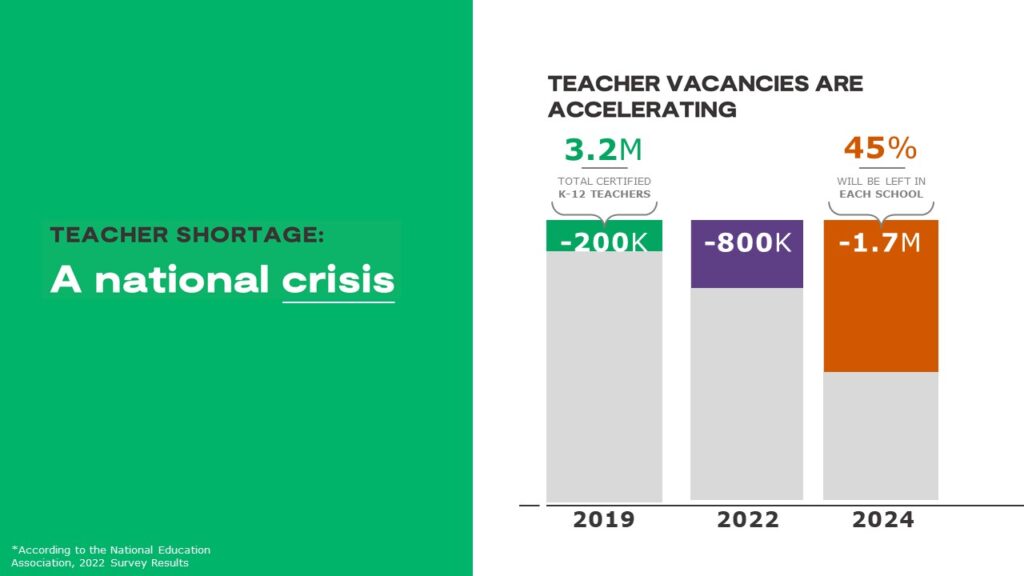
98% of School Districts Report Shortage in Special Education Educators
And, so, 98% of school districts in the US have reported a shortage in special education educators. And, obviously, as you know, there is a huge risk to leaving those positions open, and also those students not being served.
And, so, Danielle, first question. So, what encouraged you and your district to seek out a solution like Elevate K-12? Can you talk to us a little bit about some of the things you were struggling with?
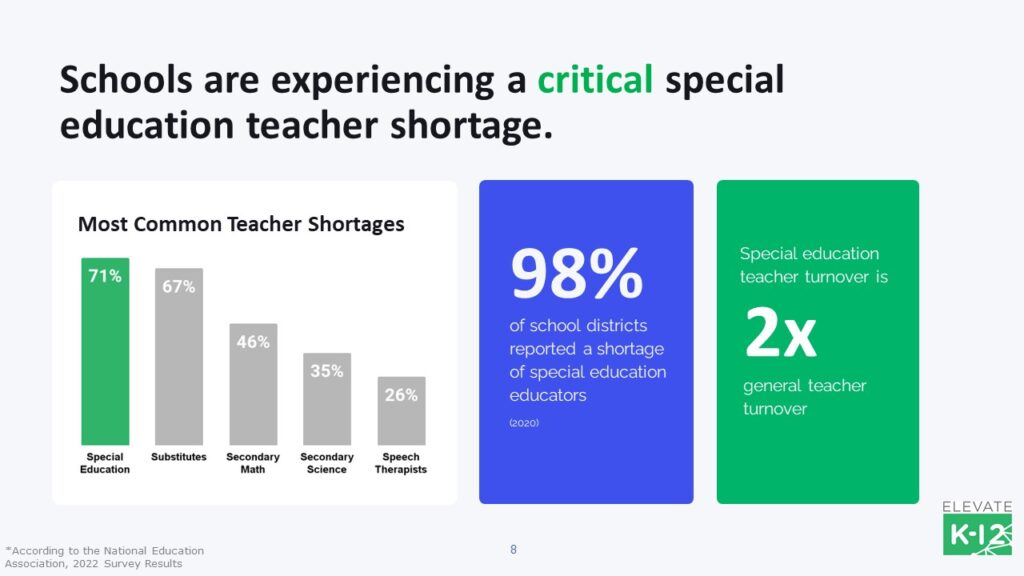
Daniel Tolbert 03:47
Well, I can’t necessarily speak for my entire district. But I can say, at my school, and particularly in the program that I worked in, staffing has been a significant challenge in recent years, very much like your data said. It’s been hard to find individuals who want to do this particular work.
Jenn Russart 04:10
And what was that leading to? Like, how was that impacting the kids?
Daniel Tolbert 04:15
Well, it’s been hard to find individuals who… Well, the program that I’m in was for kids with emotional and behavioral disorders. And, so, finding individuals who have a passion for that population, and who want to work with them left the kids not getting that full high school experience, the full academic and really social experience that high school can provide. We were left up wanting in those areas.
Jenn Russart 04:53
Yeah, absolutely. All right. Alison over to you.
Special Education Compliance
Alison Pollock 04:57
Yeah. I’m here to talk a little bit about special education compliance. So, I’m thinking about servicing the students in Danielle’s district or Danielle’s school, and also supporting, kind of, the teacher shortage in general. In the population of special education, we need to work to achieve compliance. So, just a little bit of research here, the education of students with disabilities is one of the most heavily regulated areas in the field of education. And, so, that leaves the education departments to evaluate states annually and assess how well each state is following the rules and regulations required of I.D.E.A, or Individuals with Disability Education Act.
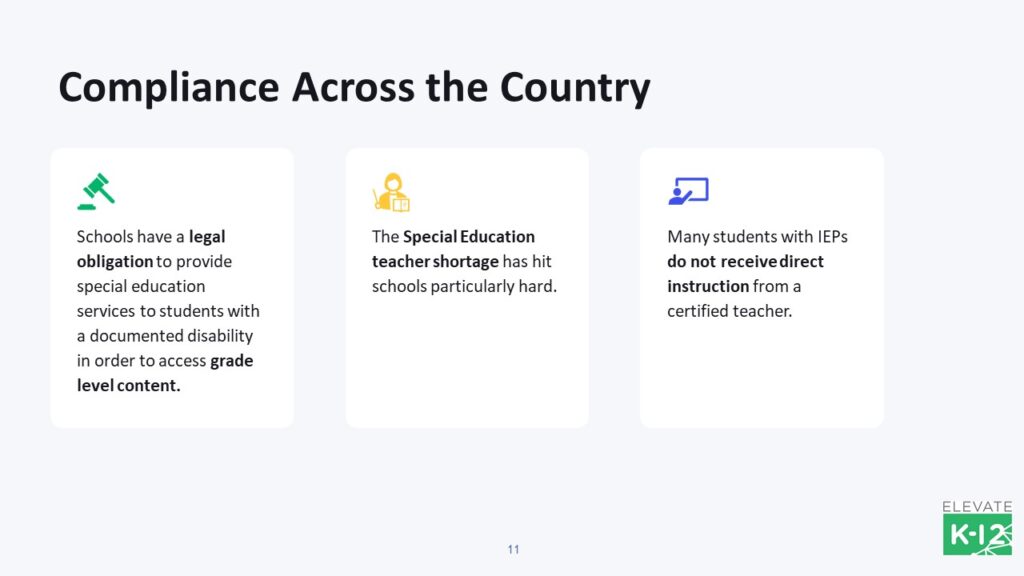
The percentage of students who are served under I.D.E.A., as you all know, is continuing an upward trend. Not only are we kind of seeing that data point shift, but other data is being looked over, as well as academic performance results. And this is being reviewed, specifically targeting the growth of students who have disabilities and ensuring that not only are we being compliant, but those students are making the growth that they deserve to make. And, so, when we look here, to speak a little bit more about compliance schools, we know do have a legal obligation to provide special education services to students with a documented disability, in order to access quality grade-level content. Obviously, the special education teacher shortage has hit schools particularly hard. And, because of this, many students with IEPs do not receive direct instruction from a certified teacher. And, so, that is what we’re here to discuss today.
Schools are utilizing a variety of models to support with students special needs, that could look like inclusion, the resource room, or, unfortunately, no support at all. So, Jenn.
Challenges in Supporting Resource Rooms
Jenn Russart 06:46
Yeah, and, we know, inclusion is highly sought after and also great for kids, right? So, these resource rooms can look and feel totally different, depending on you know, where they are. But, Danielle, what were some of the challenges that you faced when you were trying to staff and support the needs of your resource rooms?
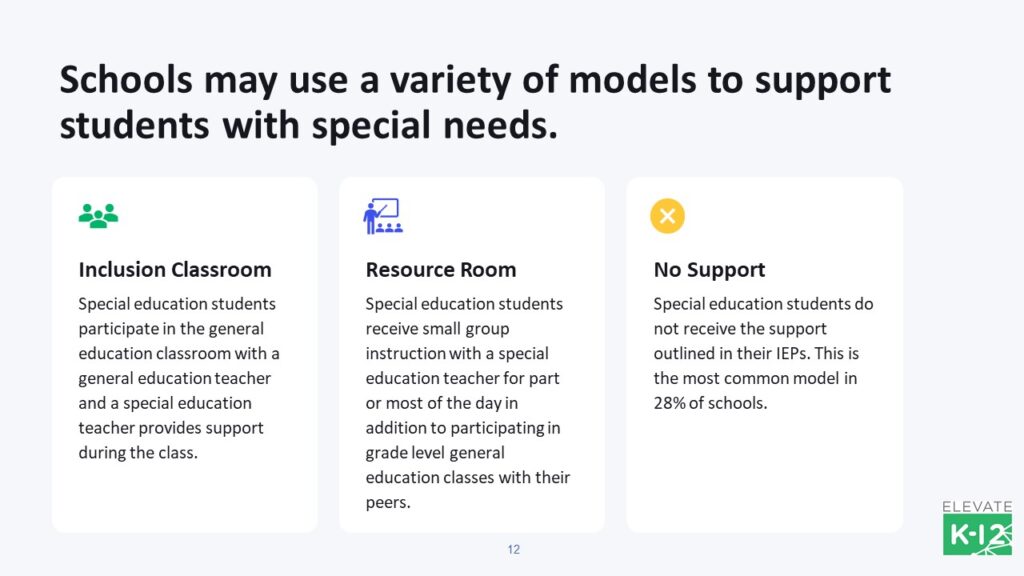
Daniel Tolbert 07:07
What’s been very difficult to find is highly skilled special education teachers who had a passion for working with our behaviorally and academically challenging population. And, over the last few years, the number of applicants has really dwindled, forcing us to seek out and utilize alternate methods for staffing the classroom.
Jenn Russart 07:28
And what were some of those alternative methods that you used?
Daniel Tolbert 07:33
Well, a lot of it was looking at teachers who we already had, that may have had multiple content certifications, but that really stretched the teachers to teach, you know, multiple subjects, and not just multiple subjects, multiple courses in those subject areas. So, making it really challenging for them to have enough time for planning and balancing that out. And then also, because our population is one with significant behavioral challenges, sometimes it created a little bit more of resistance, when they were with a teacher, for the majority, a specific teacher for the majority of the day. So, not creating that kind of diversity amongst the teaching staff.
Too Much Falling on the Paraprofessional
And then it kind of increased the level of burnout, it also increased the responsibilities of our paraprofessionals. And because some of our paraprofessionals were having to step in and hold more teacher responsibilities, just because there weren’t teachers there. So, they had to take on more tasks so that the teachers could provide the instruction. But, some of the data collection and just the day-to-day requirements that will be on a teacher were falling on the paraprofessionals.
Jenn Russart 08:45
Yeah. And then, so, if I’m hearing you correctly, in that instance, the paraprofessionals are also partially managing the IEPs as well, or how did that part work or who at the district had to get involved to ensure that we were meeting those minutes and how they’re being tracked?
Daniel Tolbert 09:04
So, the paraprofessionals weren’t necessarily having to hold some of those IEP responsibilities, but some of that may have fallen on individuals in my role, as a lead teacher, to really ensure that every aspect of the IEP was being met and facilitated, and, so, it just allowed growth for many staff people who were holding responsibilities that weren’t necessarily initially their’s, but it was more taxing on individuals and certain things that were, I guess, could be considered luxuries were put by the wayside. Some of those more fun tasks, some of those things that created more of a student investment in school. Some of those things had to be put to the side if we were ensuring that we were meeting IEP requirements, meeting academic requirements, district and state requirements; to ensure that all those boxes were checked, some of those other things had to be put to the side, which just really diminishes some of that high school experience.
Jenn Russart 10:13
Yeah, for everyone, right? And, so what I’m also hearing, is, so, then were you or someone in your position, then also observing the classroom every once in a while to just check for, like, how the classrooms are being run? And what were some words some of the your observations when you would visit the classes?
Daniel Tolbert 10:32
Well, prior to Elevate, not only observing the classroom, but maybe even facilitating instruction. And, so, sometimes, you know, in a role like mine, if I’m also the “disciplinarian,” the kids are like, “What are you doing in here? What do we do? You didn’t do anything”. But I’m here to support you and to support this, the teachers. And so I think sometimes it can be good in a way, but it’s sometimes blurred the lines about roles and responsibilities, and so kind of blur the lines of the students responses, because they’re like, “Well, who am I answering these questions? To you? Or to the teacher? Where’s the teacher?” You know, so it kind of, and when I’m working with kids with emotional behavioral disorders, they’re gonna tell you what they think, pretty upfront. And so I wanted them to be able to feel like, oh, no, he or she comes. I didn’t want that to be the case. But then to really have an authentic experience within their classroom that didn’t include the principal coming in.
Jenn Russart 11:38
Yeah, absolutely. And then how was it different after you implemented Elevate? How did your role change? And what did that look like? Can you describe that for us?
Daniel Tolbert 11:48
Well, my role… I was much more involved with the back side of things. But, they could still have their experience in the classroom with their teacher. What that felt more between them and their teacher, but then I had the opportunity, having a lot of involvement with the teachers and with my Elevate team to help mold and guide what was going on classroom without necessarily physically being in there.
Jenn Russart 12:19
And so, Ellie we’ll kick it over to you.
Elevate K-12: A Solution to Special Education Needs
Introducing Elevate K-12’s Resource Room
Alison Pollock 12:21
Awesome, awesome. So, what we have done here as we have started to employ Elevate Special Education Resource Room, in districts like Danielle and other states across the country. So, when we’re talking about our Elevate Special Education Resource Room, this ensures that schools can more fully support students who have IEPs, and support and maintaining compliance providing small group, slower-paced instruction by a certified special education teacher who can serve as that teacher of record. Students will get more supports that they are legally entitled to, and schools can work toward becoming more compliant. The Elevate resource room itself is very versatile.
Versatility of Elevate Resource Room for Different Classroom Models
We know that people have been creative this year in providing those service minutes. And, so, the Elevate resource room is the same. The resource room can look like a traditional resource room pullout, or a double dip of grade level content. So that could look like kind of an enhancement to inclusion. This resource room can look like core instruction standalone self-contained, and an alternative school or transitional programs, similar to what Danielle’s experience was. This resource room also is versatile in that our teachers providing those direct instructional minutes to students can support and alleviate case loads of teachers who are still in the classrooms and still needing to be pulled in so many different directions.
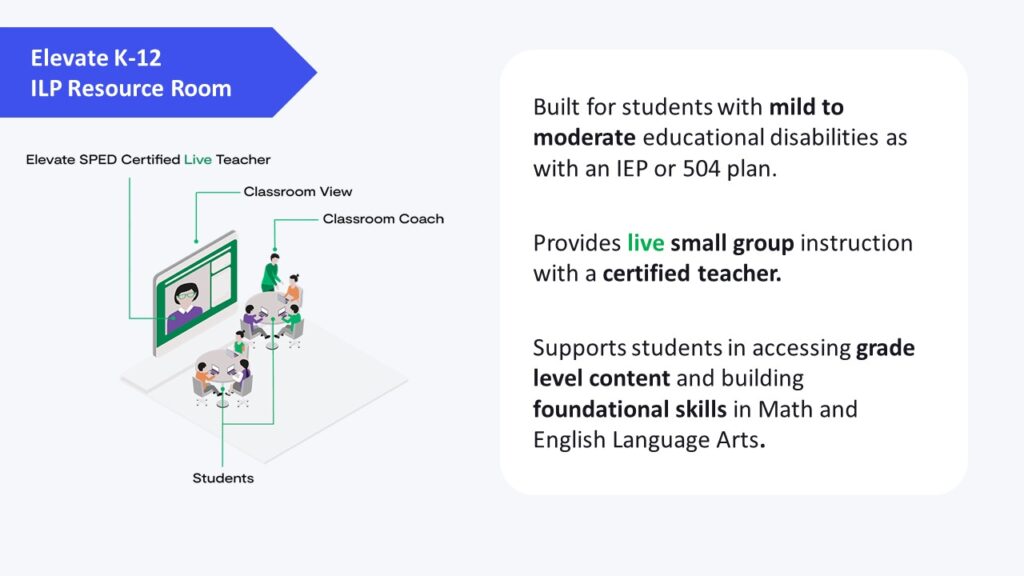
So, by Elevate supporting and alleviating those case loads, it allows teachers to be more comprehensively present to support all of the needs of the school outside of that direct instruction minutes. When we look at our resource room, this is going to be a smaller group space. And, it’s going to look similar to our core instruction classes. But rather than a general education teacher being on the front of the screen, a special education teacher would be streaming in live. The students could attend their general education class and be pulled out for a portion of the time. Again, they can attend the Elevate resource room several times per week in addition to their full general education class. And the students could also attend an Elevate resource room and receive their core content or credit per their IEP based on those minutes, how their minutes are written, we are able to service and be versatile in our support of that.
Keys to Elevate’s LIVE Special Education Resource Room
So, let’s talk a bit about implementation. There are five keys to the Elevate live special education resource room. We’ve already talked about our certified special education teacher. But, one thing that I also want to add is that we have adapted our content and our resources. Our math and ELA content has been built by subject matter experts to ensure that state standards and national standards are met. From there we- oops. And here is our elevate teacher. This is Miss Ingram. I’m going to back up just a little bit. There we go. Backing up just one here. Thinking about our adapted content and resources, we do have our special education subject matter experts come through and comb through that content to ensure that all ambiguity is removed. And all of our standards and skills are focused on those major standard clusters, allowing students increased accessibility to grade-level content, but also success in this space. We’ll talk about our inclusive learning coordinator here in just a bit. But, our inclusive learning coordinator will be an Elevate employee, who is again employed by Elevate to support your school in your district, and making sure our accommodations and modifications are delivered, with entirety and successfully throughout each and every class period. And this communication will happen through an increase in collaboration from our inclusive learning coordinator to your school or district site supervisor.
Highly Skilled and Experienced Elevate Teachers
So, here we have our hourly resource room teacher and this is just one of them. This is actually one of our mentor teachers, Mrs. Ingram. She’s had 22 years of experience in special education, a bachelor’s degree and also a master’s degree from Walden University. She feels truly blessed and enjoys her job at Elevate and she states it’s a privilege to get to work alongside students in their academic and behavioral journeys. So, similar to what Miss Tolbert had said earlier, Miss Ingram identifies that, as an Elevate virtual teacher, it’s also important that you are not only academically supporting students, but behaviorally supporting their journey as well.
This is one of our academic coaches, Danielle. Danielle also has a wealth of experience containing a master’s degree, not only a bachelor’s degree, I should say, an elementary ed in special ed but also a master’s degree in the autism spectrum disorder. She, too, is so thankful to have the opportunity to reach so many students, although she’s not a classroom teacher, she does have the blessing to be able to impact teachers across the country that are interacting daily with students. And so here’s some quotes from the classroom that we can go ahead with, feel free to read those. But while you’re reading those quotes, I want to ask Danielle, Danielle, what feedback did your staff and/or students have from their live teaching experience in an Elevate special education resource room? Are you there Danielle? Uh oh.
Steven 18:00
Oh, let’s see. I saw she jumped.
Alison Pollock 18:06
That’s okay. You know, what we can do is I can go ahead and share some of the feedback. Perhaps these are quotes from her classrooms. The students and teachers alike enjoy this experience. So, the Elevate special education teachers believe what the scaffolds and supports are built in. And they are adapting that the content that is good for teachers and also for student predictability. Special Education supervisors, like Danielle, are impressed with the teachers fluidity and accommodating lessons and enjoying how elevates platform has built in differentiation within our systems. And then, lastly, we have an impressive Special Education supervisor here to say they are just impressed with how well the program is going. In general, the virtual space really does kind of enhance the learning experience for our students with diverse learning needs simply because we do have a lot of ways to engage students and reengage students who may have fallen off tasks. Looks like Danielle is back. Danielle, are you with us? Okay, we’ll go ahead and we’ll move forward and we’ll get back to this later.
Inclusive Learning Coordinator
So, an Inclusive Learning Coordinator is a really really important person who is employed through Elevate and supports each and every resource room program. This Inclusive Learning Coordinator collaborates at least twice per month with the school special education program. And during those meetings, virtual observation data is reviewed. And during those reviews, we make sure that our Elevate team and instructional team is providing quality instruction to students. And, if coaching needs to occur, this is where that can be addressed as well. The Inclusive Learning Coordinator and the school site supervisor or case manager are consistently reviewing accommodations and modifications outlined and children IEPs. We know that students need change and evolve. And, so, what we want to do is we want this partnership to maintain current best practice, and implement those accommodations with fidelity and excellence. And lastly, this inclusive learning coordinator is going to deliver data to each school at the individual student level with student attendance data, student engagement data, student participation data, as well as formative and summative assessments. That data, being packaged with a pretty little bow, could then be utilized to progress monitor IEP goals and/or serve as the grades for the students in you know, the the LMS or the student information systems. So, again, just the most important part of this role, and our partnership in general for special education, is to ensure that all stakeholders remain current with best practices. And this inclusive learning coordinator will be the cheerleader and doing so.
Engaging and Supportive Classroom Environments
Danielle, did we get you back? We’ll come on back to Danielle in a little bit. So, when we’re talking about consistent collaboration, we know that students with disabilities and 504 plans have increased needs. And, so, what we want to do is we want to increase the collaboration and ensure that that line of communication remains open and clear. This all being said, there are collaborative opportunities between the teacher and the school-based classroom coach that is a core part of this Elevate product. We know that our virtual teacher can provide accommodations and modifications from their teaching space. But, also we need our classroom coaches to deliver those in-person accommodation such as additional bathroom breaks, or, perhaps, you know proximity for student focus. Frequent formal collaboration check-ins between our special education teachers, teacher and instructional team, and the classroom coach, will occur to review student needs. Collaboration logs and notes will ensure that all stakeholders are up to date on student progress, and consistent contact with the school and district, such as Danielle and her team, will be available to support students evolving needs. All right, Jenn, do you want to hit on some of our successes here? You’re unmuted.
Positive Student Feedback and Impact on Benchmark Assessments
Jenn Russart 22:29
Fellas, oh my gosh, we haven’t been in this virtual world for a bazillion years now. So, as we discussed earlier, Elevate can be, as a tool strategically used and deployed throughout each of your districts to solve your unique problems. And, so, oftentimes, what we’re faced with is, “hey, you know, I really want that in person, teacher, right, like in person is always better.” But what we’re finding is that with this modality and our live teaching that we’re actually able to deliver similar results, sometimes better, right, than your traditional teachers; the big piece being, you know, we’re really looking for those high quality teachers that have 13 years plus teaching experience, but then the ability to be able to connect with our students in this unique modality. And, so. we wanted to leave you with some statistics from what we’ve captured from our programs.
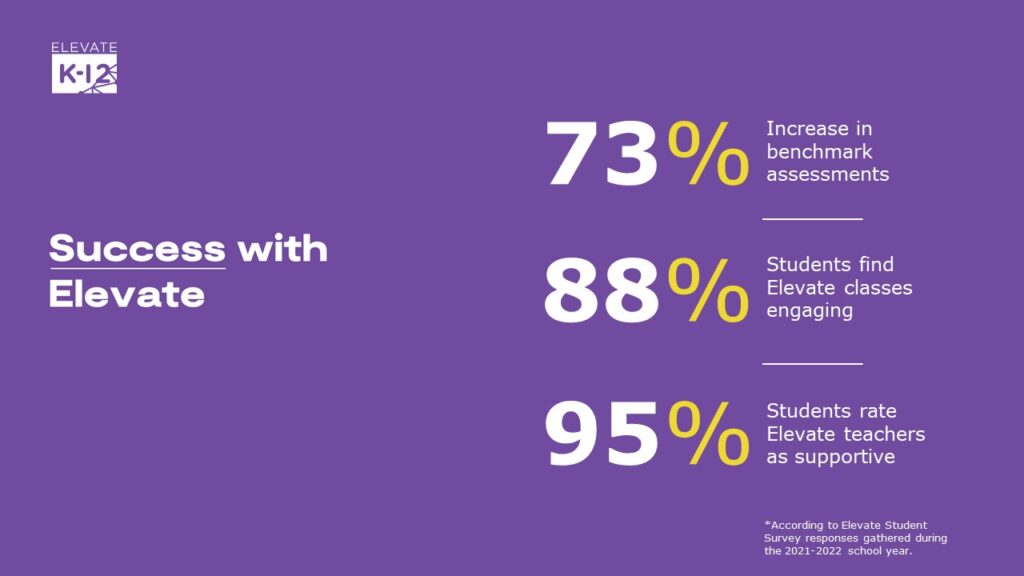
We’ve seen a 73% increase in benchmark assessments for our students. Now, it’s a host of different ways that we’re able to deliver those results. But, really a big piece of it is aligning, you know, our platform with those students and being able to modify and differentiate the curriculum to meet students where they are, be it there, in our exceptional or special education resource rooms, or in the traditional classroom. The other thing is 88% of our students find the classroom engaging. So, our teachers are still able to build relationships, make those connections, you know, in this format, which is very different than the way that everyone on this call went to school. And then the third, the third metric that we also like to point to also ties into that relationship building, is that 95% of our students rate the Elevate teachers as being supportive. And, so, not only do they know the material, but they also know how to connect with those students in the room. And, so, we wanted to leave you with that before we open it up for some questions. And Danielle’s back, yay.
Daniel Tolbert 24:23
So sorry. That’s okay. We’re glad you’re back.
Alison Pollock 24:25
That’s okay. We’re glad you’re back.
Jenn Russart 24:29
Yeah, super glad. Alex, go ahead.
Elevate’s Classroom Coaches: Leveraging Paraeducators for Support
Alison Pollock 24:32
Yeah, I was just gonna say, I do see that we have a question in the chat. And I’d love to address that. And then what we can do is, we can back up to some of the questions, should we have time. And, I’m so glad that Kathleen had asked this, “Danielle, how are you using para educators in this compliance crisis.” So, how are you utilizing paraeducators, paraprofessionals, who support the Elevate space?
Daniel Tolbert 24:57
That’s a really good question. And, so, elevate has what’s called Classroom coaches. And, that’s how our paraprofessionals or para educators are used. And that is the person that is physically in the room, ensuring that maybe a student who has IEP accommodations that require, like she said, proximity or frequent breaks; they are ensuring that those things are being provided. All of our students have behavioral intervention plan. So, they’re supporting the students in those ways. And then, they’re also supporting the teachers that there may be handouts, or even when they feel it is that are needed for the classroom instruction, they’re ensuring that those things are provided to the to the students. It also helps because not all students learn the same way. So some students can look at the the computer or the promethium board, the smart board and get the information they need. And, others may need to take notes, with guided notes and things like that. And, so, they’re ensuring that those pieces are in place so that the teacher can do what they’re doing from instruction standpoint, and the students have everything that they need to support them academically and behaviorally.
Steven 26:08
Perfect. I actually just want to jump in really quick, sorry about that team. So we have about three minutes left until we get to that 30 minute mark. But yeah, if you wanted to go back to those that early part in the presentation, please feel free to do so.
Alison Pollock 26:26
Absolutely. I think that with the questioning early on, in the dialogue between Danielle and Jenn, we were able to really capture a lot of the questions throughout. Jenn, did you want to kind of, with the last few minutes, share our general education offerings and end with some things here to wrap up.
Jenn Russart 26:42
Yeah, awesome. Also, thank you so much. We have people from Hawaii on this call, we’ve got some Arizona, I saw some Missouri, some Michigan. So, hi, Michigan, I’m from Michigan. So, so nice to see such a nice cross section of the US represented on this call today. So, real quick, for those of you who aren’t familiar with Elevate, obviously, this is more tailored towards special education. Allie and I would be more than happy to, you know, schedule time with you if you’d like to dig a little bit or dive a little bit deeper into how we can support your district in particular, you know, feel free to reach out to Elevate and we’ll get that booked. So, we shared with you previously, our course offerings, so it is, like, very lengthy.
Elevate’s Comprehensive Course Offerings
Over 50 Courses Covering Elementary to High School Levels
So we have a bunch of different courses, over 50, between now Elementary, right. So, one of the things that we learned, in meeting when working with so many partners is, the amount of learning loss that we’re seeing as a result of COVID. Right, our sixth graders oftentimes are reading at a third and fourth grade level. And, so, in order for us to have that same level of impact with our partners, is we’ve actually built out those early earlier grade levels so that we can start to scaffold that content when we’re meeting your kids where they are, even those that aren’t in a traditional resource room or exceptional children’s or special ed program.
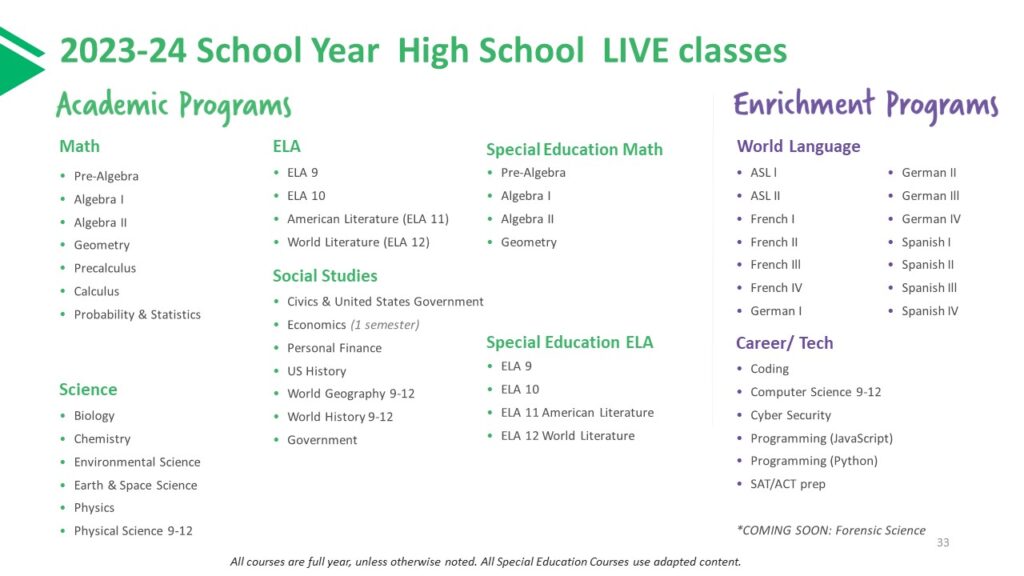
Enhancing Learning Experience and Bridging Learning Gaps
And, so, we’ve added Elementary, and we go all the way up through high school. And, so, we’ve got some really cool electives. Computer Programming, coding, as well as many of our partners will use us for their foreign language programs as well. And, so, really, the best way to think about Elevate is we can be another tool in your toolkit when you’re trying to figure out how do we get quality instruction in front of our students. And, so, yes, it’s a little bit different than some of the other levers that you’re pulling, right, like your international teachers, you’ve got kids, you know, oftentimes, people that are recent college graduates that are being in front of the classroom for the first time’; we’re starting to see many of our partners think about how to use Elevate is also another teaching tool to help mentor and guide some of those greener teachers or teachers that may be coming from overseas that are still acclimating to life in the US.
Funding Made Easy with Elevate K-12
So, there’s a ton of really interesting ways to leverage our platform in your districts, in addition to those obvious gaps that many of our partners are feeling with special education. And, so, when you’re thinking about how to pay for Elevate, typically our partners are using FTE funds.
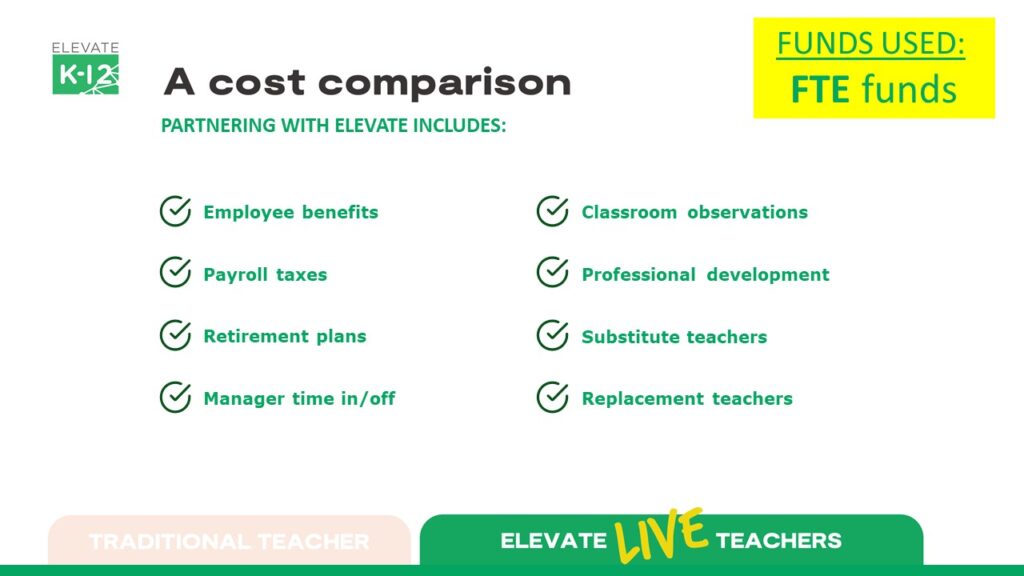
And, so, we can also help you to, you know, really understand what that cost breakdown is. And then, what are potentially some other areas, you know, where you could, you know, pull funds to be able to to provide your students with something like Elevate, which again, is typically going to drive those outcomes that we’re all looking for, and those, you know, improved scores on the benchmark assessments for our traditional and diverse learners. And, so, we leave you with hundreds of districts are already using Elevate LIVE, and I think this year, we have run close to 5000 programs throughout the US. So, we’ve got a massive network of teachers that are ready to be deployed in your districts.
Steven 29:56
Perfect. Well, thank you very much. We’re at the 30 minute mark here. But, I’ll just say that if there are any questions that we didn’t get to, or as I go through my closing slides in just a few moments, please feel free to continue in putting questions into the Q&A. And I’ll make sure that they’re all sent to our friends at Elevate K-12. So, they’ll be answered at some point in the future. But, first off, before I do that, thank you again to Danielle, Allison, and jazz, for sharing your expertise and time with us today, we really appreciate it. And, you know, of course, thank you to Elevate K12. And, I’d also like to take a minute just to thank you, our audience, for joining us here today. For those who enjoyed our presentation, we have more DA Ed talks like this one that are provided by us at DA, which is the leader in editorial coverage of news, trends, as well as current issues in K-12. We have a wide range of readers who subscribe for free to DA, and stay up to date with us in our print mag, online newsletters, webinars and DA Ed talks like this one. Also, for those of you who like to watch this at DA Ed Talk again, or for those who would like to share these solutions with your colleagues for being helpful, when I’m sure that is the case, you’ll be pleased to know that our team at DA will be sending you an email some point later tomorrow. And that email will include an on demand recording of this DA Ed talk as well as a link to the slides. So with that, on behalf of DEA, this is Steven Blackburn. Thanks, everyone. Have a great rest of your day. Thank you very much. This was great.
